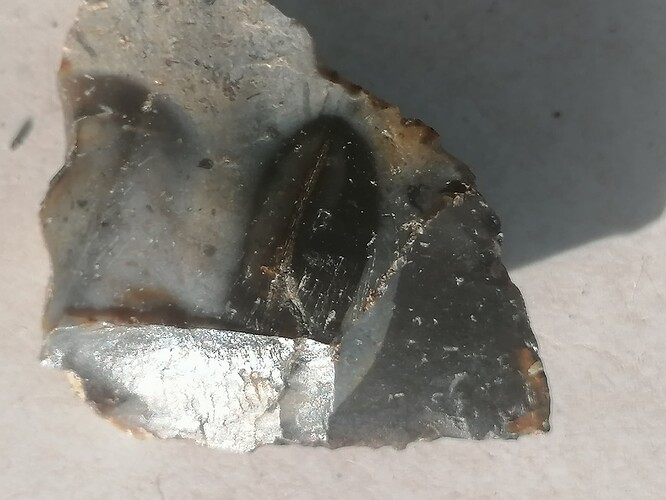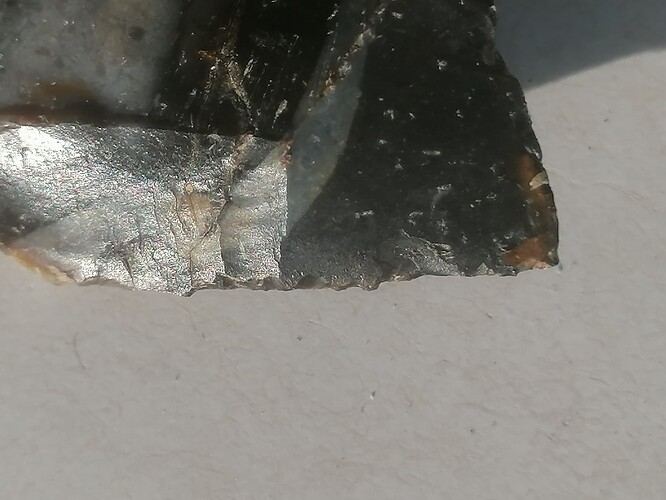Hallo zusammen, ich wollte euch jetzt doch nochmal meinen ersten Silex-Fund zeigen, ich habe ihn gerade noch einmal (hoffentlich) genauer fotografiert. Kann natürlich schon sein, dass das alles natürlich ist, aber der eine Rand sieht für mein laienhaftes Auge schon nach Bearbeitung aus. Oder ist da einfach nur Hoffnung der Vater des Gedanken? Was meint ihr?
Hallo EmmaPeach,
da muss ich dich leider enttäuschen, aber ich kann da keine Merkmale deer Bearbeitung erkennen, das wirkt alles natürlich.
Viele Grüße
na, macht nichts ![]() . Mir kommt schon noch was in die Finger!
. Mir kommt schon noch was in die Finger!
Moin Emma,
auf jeden Fall weitermachen. ![]()
Bei diesem Fund sind keine Bearbeitungsmerkmale zu erkennen.
Es ist noch nicht lange her, da habe ich schweren Herzens einige meiner
ersten Funde entsorgen müssen - nach über 40 Jahren … ![]()
Gruß
Jürgen
oje … meine “Pfeilspitze” werde ich nie wegwerfen, das war so ein toller Moment, dieser allererste Flint überhaupt, seitdem lodert das Feuer! Vor allem habe ich auf den dortigen Feldern noch keinen einzigen Abschlag gefunden, und ich bin täglich dort, ausschließlich abgerollte Steine, deshalb ist der schon deshalb was Besonderes für mich. Heute und morgen regnet es, und bald werden sicher auch wieder die Felder bearbeitet, mehr ebene Flächen für mich ![]()
Moin,
das Verhängnis / Schicksal aller (Steinzeit-) Sammelnden:
"Wenn es erst einmal in der Hand ist … "
“Man sieht nur, was man kennt …” (frei nach J. W . v. Goethe)"
Gruß
Jürgen
Hello EmmaPeach
As in most of the artifact groups I see. An awful lot of naysayers.
In my opinion it sure looks micro flaked.
People expect big fancy arrowheads, points, knives and scrapers.
In many places where water is around. Or had been present in the past.
I call these finger knives. A completely adequate tool to clean small game and fish. (Thumb and index finger knives, have you
In a communal water setting where fish were plentiful. I believe they were left around for whoever needed a small blade to clean fish or small game.
Perhaps a point? Hard to tell from the photos?
I think we can use our imagination and ponder the magnificent overabundance of flora and fauna the world saw 10k, 20k, 30,000 years ago, and more.
Regards, GL HH
ArtTfact
Moin ArtTfact,
Willkommen hier.
Vielen Dank für Deinen Beitrag.
So gesehen kann man jeden natürlichen Splitter mit scharfer Kante
als Messer verwenden.
Solche natürlichen Abschläge oder klingenartige Splitter ohne Bearbeitungsmerkmale
kann man allerdings ohne Gebrauchsspurenanalyse (Labor) nicht als Artefakt verifizieren.
Demgemäß sind wir auf die Merkmale der intentionellen Herstellung, wie Abschlagmerkmale / Retuschen u.a. Kriterien angewiesen.
Gruß
Jürgen
Hi ArtTfact,
Thanks a lot for your input, highly appreciated! I don’t have the impression there are many naysayers in this group, it is in fact a very supportive and helpful group. While it would be great it my flake was an artifact - and as long as the final verdict isn’t out, i.e. someone has seen it in the flesh and told me otherwise, it still could be one - but more important to me at this stage is to learn as much as I can. So I appreciate every opinion, hint, explanation I can get.
As for the flake itself: There is water nearby, and I suppose there must have been a larger stream then. In our small village we have two square ditched enclosures (late La Tène period) and several settlemente (prehistoric to Middle age) in close vicinity, so it could very well be such a finger knife. All I can find in this area is the occasional rolled flint, no flake or rougher stone so far, so it was a bit strange to see this flake that looked like some an arrow head. But no matter what, it started the fire and I find so much delight in my new hobby, it is awesome!
EmmaPeach,
Greetings,
How fun! Good for you! I started hunting at a very young age. Didn’;t find much until my teens.
Sure looks like tool material to me. I have dozens of quart jars full of debitage. ‘Finger knives’ some of those pieces. (Do people need a gargantuan knife to make it more bite size? Doesn’t take much for fish or small game.)
You’re on the right track IMO. Look for things and rocks that look out of place.
I think that you’re very lucky to be able to find things dating back 30,000 or more years. On that topic, an artifact from that far back would be very worn over time. If on the surface.
Looking like the artifact timeline here dates back perhaps 25.000 years maybe a little more?
On the hunt myself for Clovis-Paleo pieces.
Found one that may be from the period.
Not sure about you? I’m a pretty adherent believer in genetic memory.
My ancestors are from Germany, France, Norway, and other parts of Eu.
Love my ancestral lineage! Love Europe!
Best Regards, GL, HH!
ArtTfact
Btw I should explain about my comment ‘Naysayers’. I was thinking more about other forums like Facebook. People can be quite rude on there. Sure, a rock is a rock. Something that has been knapped-worked is a whole other story. When it comes to personal finds. People just can’t argue legitimacy. I’ve kicked years of dirt…
Hi there,
Thanks for the encouragement, I will definitely go on searching! So you are in New Mexico? I’ve never been to the USA, but I regularly watch archeology documentaries from over there (but mostly from the UK, I just have a soft spot for the island(s) and its history. Would love to live there. They have so many opportunities for volunteers to help with excavations, it is a shame we don’t have that here. So I am continuing learning on my own with the help of those kind people here and the info they are willing to provide.
Can you share any finds maybe? I think it would be interesting for many here - and I am happy to translate, if necessary!
(btw, regaring lineage: I did some DNA test a few months ago, seems I am pretty much Viking/Celtic, which isn’t that much of a wonder, considering where I live ![]() . I though I might have some strong links to some Eastern people due to my blood type - B+ oder AB*, can’t remember which of them), but no. That was more astonishing than the rest.)
. I though I might have some strong links to some Eastern people due to my blood type - B+ oder AB*, can’t remember which of them), but no. That was more astonishing than the rest.)
Hello! EmmaPeach!
You didn’t mention what part of Europe you’re at? Do you know your haplogroup?
We could be related!? Ha!
Actually, I’m in Colorado. Here in this state Co. a site just found not far from me, a kill site. They ran herds off of a cliff. There are many Paleo sites in Colorado. 'In fact, the earliest human trace in North America has been found in White Sands New Mexico. (Border state with Colorado). Though there still is quite an academic debate. Link below VVV
Tracking Humans’ First Footsteps in North America
The below link is really fascinating! VVV
World’s first vehicle? Archaeologists uncover 22,000-year-old tracks in New Mexico | Archaeology News Online Magazine
Btw, I’d gladly share some photos of some of my whole artifact finds.
Give me some time. I keep them buried and well hid ![]()
Having some issues with my camera also…???
However, I will not forget you.
Do what you love EmmaPeach. Life is too short for anything but.
Everyday new and exciting things are being found!
Get out there and make the next amazing find!
Fondest Regards,
ArtTfact
Hallo zusammen,
ich wollte noch kurz rückmelden, was die Dame vom Amt zur meiner “Pfeilspitze” gesagt hat: Es ist natürlich keine, aber es hätte evtl. eine werden sollen. Sie hat wohl schon irgendwelche Bearbeitungsspuren ausmachen können, aber das Ding wurde wahrscheinlich verworfen, aus irgendeinem Grund (es war so viel Info in den 3 h dort, ich kann mich leider nicht mehr erinnern, was genau sie nochmal dazu gesagt hat - blödes Meno-Brain:roll_eyes:). Ob es nun eine ist oder hätte werden sollen oder auch gar nichts, ich behalte den Stein so oder so, eben weil in den Feldern rundherum nur sehr abgerollten Silex zu finden ist, keinerlei Abschläge oder abgebrochene Teile, weil es dort halt auch so gut wie keinen Silex gibt, und ich einfach nicht denke, dass ein Stein in dieser Form einfach so dort entstanden ist. Und ich mag ihn einfach ![]() . Ist ja auch spannend, nicht die ganze Geschichte zu kennen und noch etwas der Fantasie zu überlassen.
. Ist ja auch spannend, nicht die ganze Geschichte zu kennen und noch etwas der Fantasie zu überlassen.


